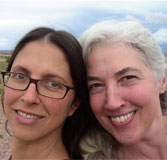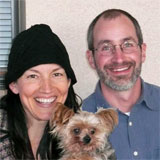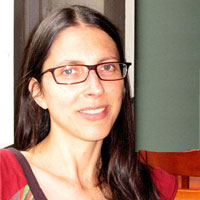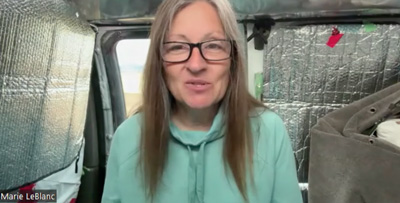

left: re|shelter co-founders Julie Genser and Julie Laffin;
right: interviewers Liz Smentowski and Scott Killingsworth
Liz Smentowski and Scott Killingsworth talk to Julie Genser and Julie Laffin, the co-founders of re|shelter, to find out more about the non-profit’s origins and future goals. Scott became chemically sensitive in 1998 following a Dursban exposure in his office. His passion for safe housing results from his experiences in 2004-2007, when he lost his safe apartment in Georgia and spent the next three years searching for a tolerable place to live. After looking at over 100 houses and sleeping on a porch for 2 ½ years, Scott relocated in 2007 to a safe house in northern Arizona. Liz became chemically and electrically sensitive after a long surgery in 2001. Since then, due to either finances or health difficulties, she has lived in a total of 21 dwellings in 7 cities, including a sailboat in a San Diego harbor. Their personal struggles with housing and resulting passion for helping others solve their housing issues made them the perfect pair to interview re|shelter’s founders.
 For those unfamiliar with environmental illness and the issue of safe housing, can you give us a brief background on this special population and housing crisis?
For those unfamiliar with environmental illness and the issue of safe housing, can you give us a brief background on this special population and housing crisis?
 JG: Environmental illness, or chemical sensitivity, is a condition characterized by an acute intolerance to low levels of chemicals, molds, and other substances. Exposure to extremely low levels of an offending substance can cause a wide variety of symptoms, ranging in severity from mild to completely debilitating, and can even be life-threatening. People who develop chemical sensitivity might also develop a hypersensitivity to other environmental influences, such as electromagnetic fields (EMFs), sound waves, vibration, sun radiation, foods, and/or mold. Although there is no universally agreed upon mechanism for environmental illness, there are some who believe that it is primarily a result of damage to specific areas of the brain, caused by chemical injury (from pesticide poisoning, solvent exposure, etc.) and/or neurotoxins from pathogenic bacteria, viruses and fungi (like Borrelia burgderfori, the spirochete that causes lyme disease, or Stachybotrys chartarum, a toxic black mold).
JG: Environmental illness, or chemical sensitivity, is a condition characterized by an acute intolerance to low levels of chemicals, molds, and other substances. Exposure to extremely low levels of an offending substance can cause a wide variety of symptoms, ranging in severity from mild to completely debilitating, and can even be life-threatening. People who develop chemical sensitivity might also develop a hypersensitivity to other environmental influences, such as electromagnetic fields (EMFs), sound waves, vibration, sun radiation, foods, and/or mold. Although there is no universally agreed upon mechanism for environmental illness, there are some who believe that it is primarily a result of damage to specific areas of the brain, caused by chemical injury (from pesticide poisoning, solvent exposure, etc.) and/or neurotoxins from pathogenic bacteria, viruses and fungi (like Borrelia burgderfori, the spirochete that causes lyme disease, or Stachybotrys chartarum, a toxic black mold).
Although the presentation of the illness can differ substantially from one sufferer to the next, many share the common experience of having severe difficulty remaining in their homes after becoming ill. Interior environments that were formerly comforting and safe suddenly become a source of great physical pain and discomfort. We are not just talking about getting headaches or the sniffles. In my own case, my home and all my material possessions affected my ability to breathe, and my ability to sleep – two functions critical to basic survival. Because of the seriousness of the symptoms, many find themselves living in their car, in a tent in the woods, or sealed up in a purified room in their home, for weeks, months, and sadly, in many cases, years.
 Yes, we can both personally relate to that. How have your lives been personally impacted by the lack of EI-safe housing and how has this influenced your desire to do something about it?
Yes, we can both personally relate to that. How have your lives been personally impacted by the lack of EI-safe housing and how has this influenced your desire to do something about it?
 JG: When I first got severely disabled by environmental illness, I was in Prescott, AZ, which happened to be a sort of mini Mecca for people with this illness. Many people flock to the southwest desert for it’s warmer weather and dry (less moldy) climate. Even though there was a community of people living with this illness in Prescott, I was still unable to find assistance getting safe housing and had to leave the area. Over the next few years on the East coast, I went from one unsafe living situation to the next, adding new challenges to my already difficult existence with each new attempt at securing safe housing; I became severely electrically sensitive after living in an apartment with high electromagnetic fields (up to 35 milligauss!), extremely mold sensitive after living in a mold infested NYC apartment, and then, I became a universal reactor, tortured daily by neighbors’ personal care product choices, as well as their use of pesticides, wireless electronics and other EMF activities. I made a harrowing 4-day cross-country drive to northern Arizona in order to rent a “safe” house in a community where about 20 others with this illness had already settled and built specialized housing. For me, the lessons I learned were simple and straightforward:
JG: When I first got severely disabled by environmental illness, I was in Prescott, AZ, which happened to be a sort of mini Mecca for people with this illness. Many people flock to the southwest desert for it’s warmer weather and dry (less moldy) climate. Even though there was a community of people living with this illness in Prescott, I was still unable to find assistance getting safe housing and had to leave the area. Over the next few years on the East coast, I went from one unsafe living situation to the next, adding new challenges to my already difficult existence with each new attempt at securing safe housing; I became severely electrically sensitive after living in an apartment with high electromagnetic fields (up to 35 milligauss!), extremely mold sensitive after living in a mold infested NYC apartment, and then, I became a universal reactor, tortured daily by neighbors’ personal care product choices, as well as their use of pesticides, wireless electronics and other EMF activities. I made a harrowing 4-day cross-country drive to northern Arizona in order to rent a “safe” house in a community where about 20 others with this illness had already settled and built specialized housing. For me, the lessons I learned were simple and straightforward:
1. If you don’t have safe housing, your illness can progress quickly, and you will probably be tortured daily by assaults to your nervous system and other organ systems.
2. Even in the areas most populated by people disabled by environmental illness, there is usually no consistent and reliable organized system for finding and creating safer housing; we are pretty much on our own.
3. Even in a community where many have built homes to accommodate their illness/disability and there is great collective knowledge about safer materials and construction practices, there is no organized way of sharing that information with the larger population who needs it.
4. There is largely a lack of assistance from the usual sources (e.g., government, local community, family) in solving this housing crisis. So even though we are sick and disabled, and sometimes barely functional, we mostly have to rely on ourselves and on our sick friends to do this work. (There are obviously exceptions to this but for many of us, we are on our own.)
The added piece for me: I have been running Planet Thrive, an online community for people recovering from environmentally based illnesses like chemical injury, for several years and I am contacted frequently by those searching for safer housing. I have heard one too many horror stories of people suffering greatly and being forced to live in their cars, or in a sealed rooms for years, unable to go outside. It would be one thing if a healthy person had to do this, but with environmental illness, people are experiencing horrific symptoms while having to make these life-changing transitions. It just became unbearable to me to go on without taking steps – no matter how small and slow – to address this problem. Especially since I had a background in design and construction from before I became disabled.
 JL: My situation shares some important features with Julie Genser’s. Many of the same substances trigger my illness and I have to practice the same rigorous avoidance of them. This means I am largely housebound because of my inability to avoid common chemicals in almost all public spaces. After leaving Chicago and environs to escape the pollution of the metro area, I ended up in an area of heavy agricultural production. My naiveté about moving to the country was shattered after I moved there and found out they were crop dusting the fields in my area frequently and extensively for at least two months of the year (in addition to massive ground spraying in spring). Each year now during July and August I have to leave northern Illinois and embark upon a safe housing quest. My first such venture was to Snowflake, AZ because I was fortunate enough to have met a compassionate couple who made their guest house available to me. When I arrived I was unable to tolerate the guest house so I slept outside on the porch for the first few weeks. In time I figured out that the fiberglass window screens heating up in the Arizona sun were causing the problem and my friends were kind enough to replace the fiberglass with aluminum. With this simple remediation, I was then able to tolerate the house and really enjoyed my stay there. When I told another environmentally ill friend about the solution she exclaimed, “Oh no, I could never tolerate being around the metal.” I realized two things: how extremely idiosyncratic the housing needs of those with environmental illness can be and how some seemingly large housing problems can be resolved with some sleuthing, effort and application of resources.
JL: My situation shares some important features with Julie Genser’s. Many of the same substances trigger my illness and I have to practice the same rigorous avoidance of them. This means I am largely housebound because of my inability to avoid common chemicals in almost all public spaces. After leaving Chicago and environs to escape the pollution of the metro area, I ended up in an area of heavy agricultural production. My naiveté about moving to the country was shattered after I moved there and found out they were crop dusting the fields in my area frequently and extensively for at least two months of the year (in addition to massive ground spraying in spring). Each year now during July and August I have to leave northern Illinois and embark upon a safe housing quest. My first such venture was to Snowflake, AZ because I was fortunate enough to have met a compassionate couple who made their guest house available to me. When I arrived I was unable to tolerate the guest house so I slept outside on the porch for the first few weeks. In time I figured out that the fiberglass window screens heating up in the Arizona sun were causing the problem and my friends were kind enough to replace the fiberglass with aluminum. With this simple remediation, I was then able to tolerate the house and really enjoyed my stay there. When I told another environmentally ill friend about the solution she exclaimed, “Oh no, I could never tolerate being around the metal.” I realized two things: how extremely idiosyncratic the housing needs of those with environmental illness can be and how some seemingly large housing problems can be resolved with some sleuthing, effort and application of resources.
 Wow—well you both have definitely walked in the shoes of those who are terribly challenged by housing. Nationwide, how big is the need for safe housing for people with Environmental Illness (EIs)?
Wow—well you both have definitely walked in the shoes of those who are terribly challenged by housing. Nationwide, how big is the need for safe housing for people with Environmental Illness (EIs)?
 JG: In two large-scale national surveys, Stanley M. Caress, Ph.D. and Anne C. Steinemann, Ph.D. found that 11.4% of the general public reported a sensitivity to common chemical products – that’s equivalent to 35 million people.1, 2 Pamela Gibson, PhD, found that 66% of people with chemical sensitivities that she studied turned to an unconventional form of housing at some point in their life, including living in their car, a tent, a horse trailer, or a purified room in their home.3 Although we need more research, according to the findings with her sample, as many as 29 million Americans may be in need of safer housing at some point in their life.
JG: In two large-scale national surveys, Stanley M. Caress, Ph.D. and Anne C. Steinemann, Ph.D. found that 11.4% of the general public reported a sensitivity to common chemical products – that’s equivalent to 35 million people.1, 2 Pamela Gibson, PhD, found that 66% of people with chemical sensitivities that she studied turned to an unconventional form of housing at some point in their life, including living in their car, a tent, a horse trailer, or a purified room in their home.3 Although we need more research, according to the findings with her sample, as many as 29 million Americans may be in need of safer housing at some point in their life.
1 http://www.thefreelibrary.com/Prevalence+of+fragrance+sensitivity+in+the+American+population.-a0195287645
2 http://www.prb.org/Topics/Census2010.aspx
3 http://www.mcsresearch.net/journalpapers/lifedisruption.pdf
 JL: As Julie Genser indicated the need is staggering and anyone who has been around the EI community for any length of time will have learned about many people struggling to procure safe housing for themselves or a member of their families. Environmental illness in still delegitimized and this in my opinion is a huge part of the problem; people suffering from EI are stigmatized because the illness in our culture at large is not taken seriously. Also, our culture’s love affair with petroleum puts people deeply into denial about the impact chemicals might be having on human health and the environment or in many cases looked at as necessary trade-offs. And there are incredible marketing forces at work to promote the use of many things that are on the market and actually harmful or potentially so. The ubiquitous presence of chemicals in everyday life is a huge contributing factor to the problem our organization is going to address. Most mainstream housing scenarios are just not going to work for many sufferers of EI.
JL: As Julie Genser indicated the need is staggering and anyone who has been around the EI community for any length of time will have learned about many people struggling to procure safe housing for themselves or a member of their families. Environmental illness in still delegitimized and this in my opinion is a huge part of the problem; people suffering from EI are stigmatized because the illness in our culture at large is not taken seriously. Also, our culture’s love affair with petroleum puts people deeply into denial about the impact chemicals might be having on human health and the environment or in many cases looked at as necessary trade-offs. And there are incredible marketing forces at work to promote the use of many things that are on the market and actually harmful or potentially so. The ubiquitous presence of chemicals in everyday life is a huge contributing factor to the problem our organization is going to address. Most mainstream housing scenarios are just not going to work for many sufferers of EI.
Yes, it’s heartbreaking on so many levels. Being a homeless or home-challenged EI has to be one of the loneliest and most difficult situations a person could face.
 Can you explain what the name “re|shelter” means?
Can you explain what the name “re|shelter” means?
 JG: “Re|shelter” is essentially a made-up word – you won’t find it in the dictionary. It made sense that we had to create our own word, in a world that does not know how to adequately define or address the housing needs of those with disabling environmental intolerances. The primary intended meaning of the word “re|shelter” is to find shelter for those who have had shelter and lost it; so we are re-sheltering them. Another meaning is “re: shelter,” or “regarding: shelter” which emphasizes that our focus is 100% on addressing housing issues. We wanted a name that was unique, self-explanatory, short and sweet, not used by another company, and it had to be available as a “.org” domain name. “Re|shelter” fit the bill.
JG: “Re|shelter” is essentially a made-up word – you won’t find it in the dictionary. It made sense that we had to create our own word, in a world that does not know how to adequately define or address the housing needs of those with disabling environmental intolerances. The primary intended meaning of the word “re|shelter” is to find shelter for those who have had shelter and lost it; so we are re-sheltering them. Another meaning is “re: shelter,” or “regarding: shelter” which emphasizes that our focus is 100% on addressing housing issues. We wanted a name that was unique, self-explanatory, short and sweet, not used by another company, and it had to be available as a “.org” domain name. “Re|shelter” fit the bill.
 Let’s switch gears a bit. You have quite an impressive Board of Advisors. How did you select the members and inspire them to join your mission?
Let’s switch gears a bit. You have quite an impressive Board of Advisors. How did you select the members and inspire them to join your mission?
 JG: We wanted to have a diverse team to reflect the diverse needs of our target population. Everyone on our team is a person of high integrity and commitment, and adds huge value to our organization. No one is on our Advisory Board as an afterthought. We selected both people who have been working professionally in the fields of environmental medicine, disability rights, architecture and related areas and are quite accomplished, as well as those who have been living with the illness and developing solutions on the ground level. We needed both – people who understand the illness from the inside out and people who understand and are active in the workings of our culture. We also wanted community “elders” who have the wisdom and insight of the politics behind our difficult history, coupled with the fresh energy and vision of those newer to the illness. We have Advisors for statistical and medical/scientific advice (Martin Pall, Ph.D., Pamela Reed Gibson, Ph.D., Anne C. Steinemann, Ph.D., Magda Havas, Ph.D., William J. Rea, M.D.) to consult with when writing grant proposals, we have Advisors with many years of experience dealing with disability rights and government housing agencies (Bennie Howard, Susan Molloy), we have architects with experience building for the chemically sensitive (Paula Baker-Laporte) and in low-income desert architecture (Simone Swan), the president of the Indoor Air Quality Association (Carl Grimes), and others who bring critical resourceful problem-solving skills to the table like Melinda Honn and John Egner, who both still live housebound and severely disabled due to MCS and ES but who have an incredible amount of knowledge about safer building materials and construction practices to share.
JG: We wanted to have a diverse team to reflect the diverse needs of our target population. Everyone on our team is a person of high integrity and commitment, and adds huge value to our organization. No one is on our Advisory Board as an afterthought. We selected both people who have been working professionally in the fields of environmental medicine, disability rights, architecture and related areas and are quite accomplished, as well as those who have been living with the illness and developing solutions on the ground level. We needed both – people who understand the illness from the inside out and people who understand and are active in the workings of our culture. We also wanted community “elders” who have the wisdom and insight of the politics behind our difficult history, coupled with the fresh energy and vision of those newer to the illness. We have Advisors for statistical and medical/scientific advice (Martin Pall, Ph.D., Pamela Reed Gibson, Ph.D., Anne C. Steinemann, Ph.D., Magda Havas, Ph.D., William J. Rea, M.D.) to consult with when writing grant proposals, we have Advisors with many years of experience dealing with disability rights and government housing agencies (Bennie Howard, Susan Molloy), we have architects with experience building for the chemically sensitive (Paula Baker-Laporte) and in low-income desert architecture (Simone Swan), the president of the Indoor Air Quality Association (Carl Grimes), and others who bring critical resourceful problem-solving skills to the table like Melinda Honn and John Egner, who both still live housebound and severely disabled due to MCS and ES but who have an incredible amount of knowledge about safer building materials and construction practices to share.
How did we inspire them to join our team? I think that there already exists a huge desire on the part of many to contribute to solving this housing crisis for those with environmental intolerances. All we did was mobilize energy that was already there, but lacked organization. We identified a problem that needed attention – housing for those with environmental illness – and offered to take leadership on the issue. That made it easy for others to participate. I also think that having my own track record on helping the MCS community through PlanetThrive.com and MCSsafehomes.com gave people enough confidence that I was sincere and would follow through on my intentions.
 Many people don’t realize that, in addition to running the Environmental Health Center—Dallas, William J. Rea, M.D. has extensive experience with MCS housing. According to his website, his Center has evaluated and aided in the construction of or remodeled more than 17,000 private and public buildings through their Home and Commercial Building Evaluation service. How did he first get involved with safer construction projects, and does his Center still offer these services?
Many people don’t realize that, in addition to running the Environmental Health Center—Dallas, William J. Rea, M.D. has extensive experience with MCS housing. According to his website, his Center has evaluated and aided in the construction of or remodeled more than 17,000 private and public buildings through their Home and Commercial Building Evaluation service. How did he first get involved with safer construction projects, and does his Center still offer these services?
 JG: Yes, Dr. Rea has extensive non-toxic construction experience – he even wrote a home building book called Optimum Environments for Optimum Health and Creativity and co-authored Your Home, Your Health and Well-Being. The fact is, there is an incredible need for safe housing and as the preeminent physician treating people with these devastating illnesses which have been systematically ignored by almost every sector of our society, it makes sense that he got involved in safer construction. After treating over 30,000 patients since opening his clinic in 1974, creating a safer home environment is still one of his top treatment recommendations. I have heard from past patients of his who say that if you don’t have a safe environment to go back to, all the money and time spent at his clinic will be lost because you will just get sick again. Building a safe indoor environment is the foundation from which all health can grow. Dr. Rea knows this, and I imagine this is why he got involved in safer construction to begin with. He is just being the best doctor he can be, helping his patients to get well. His Center is still involved in building projects and anyone interested in his services should contact the Center directly.
JG: Yes, Dr. Rea has extensive non-toxic construction experience – he even wrote a home building book called Optimum Environments for Optimum Health and Creativity and co-authored Your Home, Your Health and Well-Being. The fact is, there is an incredible need for safe housing and as the preeminent physician treating people with these devastating illnesses which have been systematically ignored by almost every sector of our society, it makes sense that he got involved in safer construction. After treating over 30,000 patients since opening his clinic in 1974, creating a safer home environment is still one of his top treatment recommendations. I have heard from past patients of his who say that if you don’t have a safe environment to go back to, all the money and time spent at his clinic will be lost because you will just get sick again. Building a safe indoor environment is the foundation from which all health can grow. Dr. Rea knows this, and I imagine this is why he got involved in safer construction to begin with. He is just being the best doctor he can be, helping his patients to get well. His Center is still involved in building projects and anyone interested in his services should contact the Center directly.
 Please tell us a little about the major projects that re|shelter is planning.
Please tell us a little about the major projects that re|shelter is planning.
 JG: Our biggest effort initially will be fundraising, because we obviously will need funding in order to bring most of our projects to fruition. We expect that the first years will primarily involve grantwriting. When we receive enough funding, we would like to award housing aid grants to eligible individuals for small renovations – like foiling a room or retrofitting a trailer to make it tolerable – and larger grants to help eligible applicants purchase safe trailers and homes. We would also like to help facilitate the construction of safer homes and healing communities. We hope to collaborate with various architecture and design schools to develop plans for an emergency campground, a pre-fab modular housing prototype, and a small ecovillage, to start.
JG: Our biggest effort initially will be fundraising, because we obviously will need funding in order to bring most of our projects to fruition. We expect that the first years will primarily involve grantwriting. When we receive enough funding, we would like to award housing aid grants to eligible individuals for small renovations – like foiling a room or retrofitting a trailer to make it tolerable – and larger grants to help eligible applicants purchase safe trailers and homes. We would also like to help facilitate the construction of safer homes and healing communities. We hope to collaborate with various architecture and design schools to develop plans for an emergency campground, a pre-fab modular housing prototype, and a small ecovillage, to start.
 JL: Yes, because our organization is in its infancy, the focus of our efforts initially will be to identify and appeal to sources whose mission is to provide financial (or in-kind) support for projects like ours.
JL: Yes, because our organization is in its infancy, the focus of our efforts initially will be to identify and appeal to sources whose mission is to provide financial (or in-kind) support for projects like ours.
 You feature the housing struggles of people from all over the world on your homepage, where you mention this is an international crisis – does this mean that will you be offering individual grants and building homes and communities outside of America?
You feature the housing struggles of people from all over the world on your homepage, where you mention this is an international crisis – does this mean that will you be offering individual grants and building homes and communities outside of America?
 JG: Initially, our services will only be for those residing in the United States. Offering grants and other services in other countries is more complicated legally, so at least in the beginning we will limit our scope. But once our organization grows and is able to amass some funding, we definitely hope to expand our reach. It is a global issue and it does need to be addressed on a global scale.
JG: Initially, our services will only be for those residing in the United States. Offering grants and other services in other countries is more complicated legally, so at least in the beginning we will limit our scope. But once our organization grows and is able to amass some funding, we definitely hope to expand our reach. It is a global issue and it does need to be addressed on a global scale.
 The grant programs for individuals sound like they could provide a much-needed lifeline to a lot of people. How will you determine eligibility for these grants?
The grant programs for individuals sound like they could provide a much-needed lifeline to a lot of people. How will you determine eligibility for these grants?
 JG: We are still developing the criteria for that. Typically, non-profits that give out grants to individuals have very strict guidelines for submitting grant applications (for example, they might require that all information is to be scanned, and then submitted through their website) and you must show proof of medical and financial need with doctors’ notes, SSDI benefit statements, medical prescriptions, etc. With environmental sensitivities, many times people cannot access a computer due to the electromagnetic fields (EMFs), or even find a physician whose office they can tolerate and who will give them a correct diagnosis. So we are working with our lawyer to determine how we can legally allow for these special circumstances so that the most disabled and neediest of us does not get shut out from getting help.
JG: We are still developing the criteria for that. Typically, non-profits that give out grants to individuals have very strict guidelines for submitting grant applications (for example, they might require that all information is to be scanned, and then submitted through their website) and you must show proof of medical and financial need with doctors’ notes, SSDI benefit statements, medical prescriptions, etc. With environmental sensitivities, many times people cannot access a computer due to the electromagnetic fields (EMFs), or even find a physician whose office they can tolerate and who will give them a correct diagnosis. So we are working with our lawyer to determine how we can legally allow for these special circumstances so that the most disabled and neediest of us does not get shut out from getting help.
read the rest of this interview on reshelter.org










Congratulations on the creation of your new organization. This is much needed. There are many people with environmental sensitivities who are looking for safe housing. I wish you great success with your new endeavor.
Thank you for your good wishes!!!
You all ROCK, thank for all your efforts and VISION!
Thank you Monet. Thanks for your generosity in sharing your photos, your work, and your story. xxx Julie
Could you kindly call me instead of emailing, for confidentiality purposes, as I have an email helper due to my severe electrical sensitivity that I do not wish to disclose my personal difficulties with…….
You may leave me a message at XXX.XXX.XXXX [removed for privacy reasons], with a contact name, number and suitable time/day I may return your call.
With gratitude,
Nicole
I am very regressed due to excessive over exposure to living without housing, and being severely electrically sensitive for way toooooooo long.